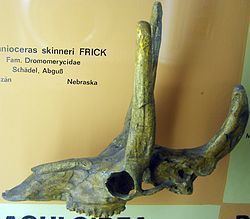Suborder Ruminantia Rank Family | Phylum Chordata Order Even-toed ungulate | |
 | ||
Similar | ||
The Palaeomerycidae are an extinct family of ruminants (thus being even-toed ungulates of the order Artiodactyla), probably ancestral to deer and musk deer. Palaeomerycids lived in North America, Europe, Africa, Asia, and South America from 55.8 to 4.9 million years ago (from the Eocene to Pliocene epochs), existing for about 50 million years.
Contents
Specimens of Amphitragulus, the earliest known genus, have been found in Aragon (Spain), Ronheim (Germany), Sardinia (Italy), France, and Kazakhstan and range from 55.8 to 15.97 million years old. Fossils of Lagomeryx and Palaeomeryx feignouxi were recovered in Germany and Slovakia from the Middle Eocene.
The oldest known North American specimen, Barbouromeryx, was discovered in Scotts Bluff, Nebraska, and estimated at 23.03 million years old. Palaeomerycids such as Cranioceras and other Dromomerycinae continued to live in North America until the early Pliocene.
Description
Palaeomerycids were a group of horned, long-legged, heavy, and massive ruminants that could attain a weight of 350 to 500 kg (770 to 1,100 lb).
One of the first known members of this group, Palaeomeryx, was thought to be a hornless form distantly related to the Giraffidae before paleontologist Miguel Crusafont found remains of Triceromeryx in middle Miocene Spain. This Palaeomeryx-like form carried two ossicones over its orbits that were straight and short, similar to those of true giraffids. However, the most striking feature of Triceromeryx was the third, Y-shaped appendage that prolonged the occipital bone at the back of the skull. Discoveries during the 1980s and 1990s showed a surprising variety in these occipital appendages.
Ampelomeryx, a genus of palaeomerycids found at the early Miocene site of Els Casots, Valles-Penedes Basin, Spain, had a three-horned system of appendages similar to those of Triceromeryx. These appendages were, however, quite different, with the paired appendages extending laterally over the orbits, flat and wide, forming an eye-shade, while the third spectacular posterior appendage was about 20 cm (7.9 in) long.
Another species of Triceromeryx, T. conquensis found in La Retama in Spain, showed an even more spectacular appendage — instead of a Y-shaped structure, its posterior appendage was T-shaped with the lateral branches expanding toward the front.
In primitive members of the group (e.g. Ampelomeryx), this appendage was a posterior expansion of the occipital bone lying close to the powerful muscles supporting the skull in a normal position, thus suggesting that this appendage was actually used for fighting between males during the breeding season. The reduced shapes of the flat and laterally oriented appendages of later species suggests that these were not used in active fighting, instead forming a function of passive display.
The limbs were more similar to those of modern large bovids (e.g. buffaloes) than to those of okapis. They probably lived in boggy forests, living on soft leaves and aquatic plants (as hinted to by the brachydont teeth, which are similar to those of primitive giraffids).
As a group, the palaeomerycids appear to have formed a successful part of an independent radiation of horned ruminants that diversified into a variety of forms during the early to middle Miocene, with a geographic range reaching from Spain to China. The giraffids seem to have originated in Asia south of the Alpine belt, while the cervoids seem to have originated north of the Alpine belt.
Taxonomy
The Palaeomerycidae were named by Lydekker (1883). The type genus is Palaeomeryx. The family was assigned to the Artiodactyla by Hulbert and Whitmore (2006), and to Cervoidea by Carroll (1988), Sach and Heizmann (2001) and Prothero and Liter (2007).
